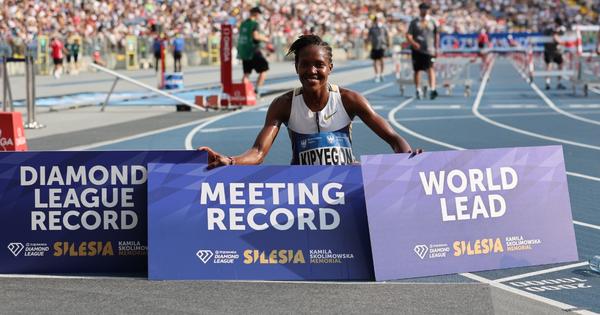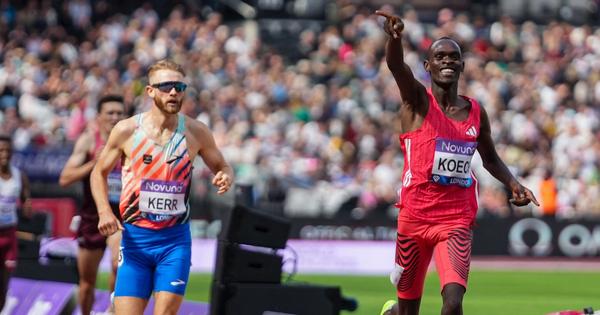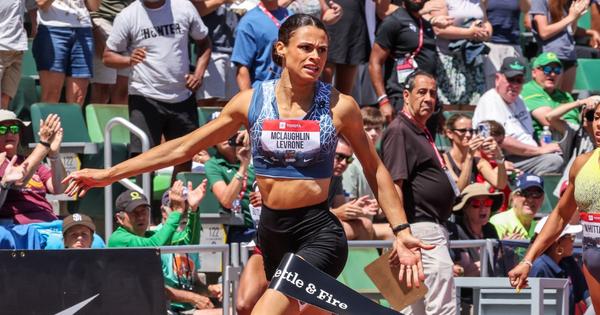By David Melly
August 20, 2025
Saturday’s Kamila Skolimowska Memorial, a.k.a. the Silesia Diamond League, featured a large blue elephant in virtually every finish line shot. And while it was annoying and intrusive from a viewing perspective, the “elephant in the room” became an apt metaphor for a lot of the action. Because in Silesia, the results themselves only told part of the story: so much of what went down in Chorzow, Poland, was made more dramatic by what we weren’t seeing or saying.
Take the women’s 100m, for instance. On the track, Melissa Jefferson-Wooden continued doing what she’s done all season: winning and running fast. This time, it was a 10.66 victory over Tia Clayton (10.82) and Marie-Josee Ta Lou-Smith (10.87), with Jefferson-Wooden’s training partner Sha’Carri Richardson running a season’s best 11.05 but finishing well out of contention in sixth. But who wasn’t there? Olympic champ Julien Alfred, who withdrew from both Silesia and today’s meet in Lausanne earlier in the week with an injury. Alfred’s been running just as well as Jefferson-Wooden all season, but in a sport with such a high injury risk, showing up can be half the battle. Alfred making it all the way from her first race on February 2nd to Worlds in September is no guarantee, and the combination of health and fitness MJW is showing off right now has to boost her into favorite status for Tokyo.
Everyone who was supposed to lined up for the men’s 100m, but plenty was still left unsaid. After their dramatic showdown at USAs, all eyes were on Noah Lyles and Kenny Bednarek when they matched back up in Silesia. And after their gold-silver finish in Paris last summer, all eyes were also on Lyles and Kishane Thompson for their first matchup since the Olympic final. And both were happening at the same time!
In the race itself, Thompson got out first and best and held off the stacked field to equal the meet record of 9.87. Since getting beaten by Akani Simbine (who finished seventh here) in his very first race of the season, Thompson has not lost over 100m since. Does that make him the favorite for gold in Tokyo? Hard to say. Mainly because Noah Lyles, the defending World champ, is treating his whole season like one of his races: starting out slow, then accelerating faster than everyone else to catch the field and come out on top. Lyles improved his season’s best to 9.90, beating U.S. 100m champ Bednarek, who finished third by a hair in 9.96—9.952, to be precise, to Christan Coleman’s 9.958, who in turn beat Trayvon Bromell in 9.97.
So Lyles was behind Thompson, but all of a sudden he’s ahead of three of the best American sprinters this season after only a few races. Will that 0.03 second gap hold over the next month? Will someone else squeeze his way back in between? For those wondering, Bednarek and Lyles were cordial in both the pre-race press conference and post-race handshakes, with Bednarek saying that the two had addressed their off-track issues. But after the race, Lyles posted and then deleted a seeming reference to the “track spice” shenanigans that started the whole mess, so who knows how long their armistice holds…
In the women’s 3000m, the collective beef the entire track and field community has with the event’s extremely sketchy world record nearly came to an end as Faith Kipyegon ran within a second of Wang Junxia’s 1993 8:06.11 mark, ultimately falling just short with a heroic 8:07.04 effort. You’ve gotta feel for the commentators in that moment—how do you professionally but accurately describe what just happened? “Congrats to Faith Kipyegon, who ran a time everyone thinks is the clean world record, but isn’t, because despite the mountain of evidence, an almost-definitely-doped mark is still officially on the books?” It’s as awkward as the giant blue elephant, to say the least.
The 400m hurdles were both defined, as they often are these days, by the question “can X beat their rival Y, who’s not even here?” Fortunately for Femke Bol, who ran a world-leading 51.91 to win by a 1.69-second margin, her great rival Sydney McLaughlin-Levrone is focused on the flat 400m this year. Karsten Warholm, however, will have to face off with Olympic champ Rai Benjamin in a month’s time, and he did his very best to put the pressure back on Benjamin to perform with a stunning 46.28 run in Silesia. That’s the fastest non-championship time in history and third-fastest ever, behind Warlhom and Benjamin’s respective personal-best runs at the Tokyo Olympics.
Prior to Silesia, Warholm had taken an uncharacteristic two-month break from racing, leading some to wonder if a secret injury had derailed his season, but clearly it was the exact opposite: the 2024 silver medalist was putting in WORK to give Benjamin the best possible fight come Worlds.
Before the international broadcast even switched on, another big star returned from a much longer break from racing. Olympic 800m champ Keely Hodgkinson hadn’t competed in over a year, entering then withdrawing from what felt like dozens of meets as she nursed a hamstring injury. When she finally did toe the line, however, it was no rust-buster: Hodgkinson blasted a 1:54.74 world lead, the second-fastest time of her career and the fifth-fastest of this century. In a little less than two minutes of work, Hodgkinson put to rest any doubt that she’s still the heavy favorite for the win in Tokyo.
Here, the elephant-in-the-room comparison is, of course, another lightly-raced 800m phenom: Athing Mu-Nikolayev. For most of this decade, Mu-Nikolayev and Hodgkinson have been forced to play the comparison game, but for good reason: they’re the same age (both 23 years old, born two months apart), came up on the international scene around the same time, and from 2021-2023, accounted for two of the three podium spots in every championship. Hodgkinson and Mu-Nikoyalev aren’t quite coming into 2025 on the same note. For Hodgkinson, it was riding the high of Olympic gold, and for Mu-Nikolayev, it was coming back from a devastating fall at the U.S. Trials, but they share the burden of sky-high expectations while they quietly worked their way back into race shape. Unfortunately for Mu-Nikolayev, the comparison is now looking less and less favorable as Hodgkinson appears well-positioned to even the score at two global golds apiece.
In track and field, as in life, context matters. There was a whole lot of baggage attached to the performances in Silesia (and we’re not even getting into the latest round of Twitter intrigue), and the fireworks, both literal and figurative, were made all the brighter if you knew the whole story. Racing with an elephant in the room makes for intriguing matchups when off-the-track tension collides with on-the-track performance… so next year, let’s double down on the drama and cut down on the mascots’ screentime.

David Melly
David began contributing to CITIUS in 2018, and quickly cemented himself as an integral part of the team thanks to his quick wit, hot takes, undying love for the sport and willingness to get yelled at online.




